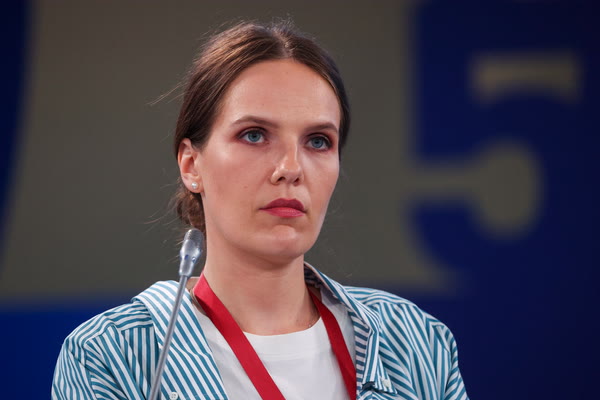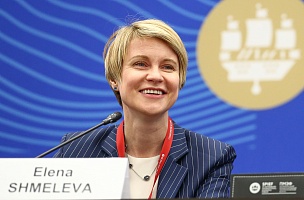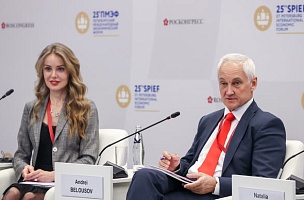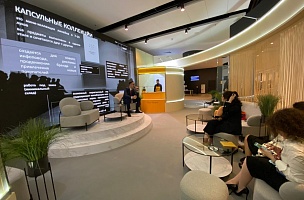Key conclusions
Media are now in metaverse
“When social networks appeared, media switched to social networks. When messengers started developing, media switched to messengers. The metaverse started evolving – media are switching to metaverse. There is a whole number of reasons for that. First of all, it means new audience, and we always want to expand our audience and convey our message. Secondly, much like any other brand, media brands go for younger audience. They want to be where young people are to develop them, instil values and patterns in them and continue to shape loyalists, who will grow up to consume our media products,” Olga Piven, Chief Executive Officer, RTVI.
The NFT market already exists and is already developed, but it is not for everybody
“A market exists, as long as there are at least two agents who can sell and buy. We are already witnessing real transactions in the NFT market. They are worth billions at the moment, but the market keeps evolving. As for us, we decided to launch a rouble-based market on our platform in Russia, because when it comes to NFT, it is still a fringe market with very few segments. It is people who are into technologies, who have cryptocurrency wallets and cryptocurrencies. They buy and sell. We decided to expand our audience and launched a rouble-based segment in our marketplace,” Ruslan Musin, Supervisor, NFT Marketplace Joy Space.
“It is cool that we find ourselves at the point of creating a brand-new market. It is alright to be in doubt. However, today I would like to tell everyone who is in doubt that it is a market with huge turnovers worth billions. This market is functioning in a totally cool fashion, because it has been around for quite a while. Every day, celebrities release news and collaborations. They partner up, as they know that it is a great marketing tool. It is an opportunity for business to support transactions, day-to-day activity, loyalty discounts and to simplify various operations. NFT makes it a lot cheaper. <...> You can monetize any type of your unique content through the NFT market, which basically makes it digitalization of all our opportunities. <...> As of today, this is a super developed economy that you cannot simply join, because whoever is the first one there get the biggest slice of that pie,” Evgenia Plotnikova, Founder, NFT CONF Ed Community.
NFT transactions make intermediaries obsolete
“When buying NFT, you are making a so-called digital transaction that lacks such obsolete elements – I think I can use this word – as intermediaries. Protecting rights is something from the past, when people would register audio recordings or something else. A smart contract would have nothing of the kind. It means that a smart contract prescribes terms and conditions and the so-called royalty for the rights holder. It means that if all of a sudden, I recite my own poem right now and turn it into NFT, my smart contract will have the author of the poem and the time of its creation, which makes it a digital footprint. If tomorrow somebody else writes the very same poem and says: ‘I wrote it,’, the blockchain infrastructure will say: ‘Dude, Ruslan recited it five minutes earlier than you did, so he owns the digital NFT certificate for this art piece.’ Another question is whether it is worth something or not. However, it registers intellectual property rights,” Ruslan Musin, Supervisor, NFT Marketplace Joy Space.
Anything from a museum to a draft law can be a digital art piece
“The New People party has submitted a draft law on NFT, which we have turned into NFT. Today, it will be sold at a charity auction. It means that before it was worth nothing, while now it can be an art piece,” Ruslan Musin, Supervisor, NFT Marketplace Joy Space.
“There is a big trend of cooperation and NFT creation by state museums, or of platform creation – the way the Hermitage did it or the Vatican and many others. Platforms are created by auction houses, galleries, and even artists themselves. This market is indeed developing so rapidly that I am curious to see how it will get divided in the near future,” Polina Bondareva, Founder, Masters School.
PROBLEMS
Metaverses are still a domain of crypto banks. The society is not ready for NFT
“As for metaverses, we do not see anything yet that would be on par with high art. There is a lot of gamification to it. <...> So far, they are all meant for crypto punks or all sorts of apes,” Milhail Kossolapov, Deputy Director in Charge of Finance, The Pushkin State Museum of Fine Arts.
“The Hermitage has created a beautiful project. Unfortunately, public opinion in Russia is not ready for it yet. I remember polls abroad where people would understand that it was something new and nice. Media released many positive reviews. Russia had an opposite situation and more negative reviews,” Ekaterina Shugaeva, Anchor, “Us and Science. Science and Us” Programme, NTV.
“The market [the NFT market, – Ed.] exists, but we do not have enough support or promotion tools,” Evgenia Plotnikova, Founder, NFT CONF Ed Community.
NFT is a grey area with no guarantees
“Intrinsically, it is still a grey area [in terms of taxes, – Ed.]. It is not defined yet. There is no regulatory framework for it yet,” Olga Piven, Chief Executive Officer, RTVI.
“When buying an NFT of an artist today, you do not know where this link will lead you in several years – will it pay for its cloud,” Milhail Kossolapov, Deputy Director in Charge of Finance, The Pushkin State Museum of Fine Arts.
SOLUTIONS
NFT opens almost unlimited opportunities for monetization
“NFT <...> is an extra way of attracting attention. We all are after traffic, hype and going viral. <...> What can it entail? It can entail a completely different way of content monetization, because now an information unit is basically a piece of art. <...> I think that when it comes to media, watch to earn will be developing as metaverses evolve,” Olga Piven, Chief Executive Officer, RTVI.
“It [NFT, – Ed.] means a broader funnel of consumers, because all museums – both public and private – have an incredible number of pieces, and nobody knows about that. <...> If somebody gets to own NFT for a certain piece, they can put a digital certificate in their metaverse office that they own Madonna’s digital copy, per say. There is nothing wrong with that. Madonna will stay where she has always been, but there will be more traffic to see the original. It means that the value of the original will be growing because of digital certificates – they broaden your experience and make everybody want to see the actual artefact,” Ruslan Musin, Supervisor, NFT Marketplace Joy Space.
“We [the Polytechnical Museum, – Ed.] view the digital layer as our second life. <...> Imagine you have a unique – let’s say – microscope. You do not just digitize it – you make its full-scale model. You understand the parameters, so start modelling experiments of that particular time. It is way more interesting, because it creates additional value and an opportunity for a rediscovery,” Konstantin Fursov, PhD in Sociology; Deputy General Director for Science and Education, Polytechnical Museum.
NFT will allow to co-own art with thousands of people
“Buying an NFT share is an important trend. Now one can purchase masterpieces. Let’s say a Picasso was worth 3.6 million, so the Particle platform split it into 4 thousand NFT and you could own each NFT for less than USD 1 thousand. Indeed, such co-ownership is very popular, and many platforms intend to buy both masterpieces and works by regular artists,” Polina Bondareva, Founder, Masters School.
Blockchain guarantees for digital transactions
“We all are witnessing how Russian users got disconnected from many cloud systems. <...> We are on the verge of cloud technologies, when things are distributed among all users rather than through one server-based cloud. <...> Basically, it is the good old blockchain, where things are distributed and confirmed among everyone, which makes it safer,” Ruslan Musin, Supervisor, NFT Marketplace Joy Space.
Blockchain is becoming part of public sector
“When it comes to regulation, Dubai’s experience, per say, is an interesting one. They are among the pioneers of switching regular things to blockchain. <...> It is an interesting experience in terms of public management. A big share of their regulation is blockchain-based,” Olga Piven, Chief Executive Officer, RTVI.
“Our regulator has imposed multiple blockchain limitations, but now we are facing different ones. I know it for a fact that private financial institutions are now testing real blockchain transactions in the real crypto currency segment. My forecast is optimistic – in 12–18 months we will be using real blockchain,” Ruslan Musin, Supervisor, NFT Marketplace Joy Space.






